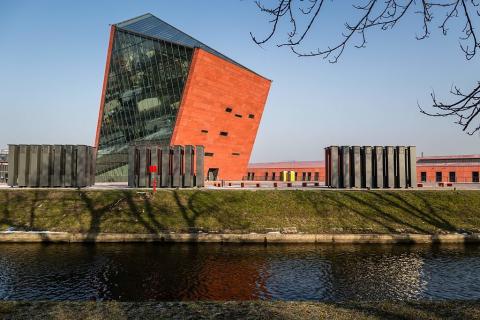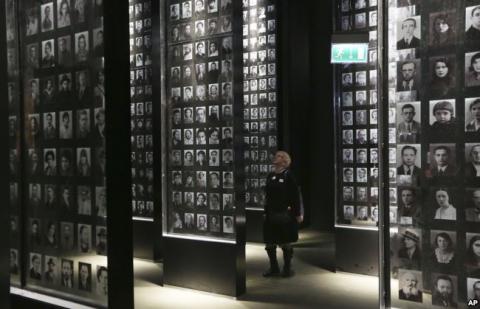Poland moves forward with refocusing history on Polish heroism and victimhood
The Museum of Second World War in Gdansk, Poland which opened on March 23, 2017 in the midst of controversy.
By Carolyn Yeager
POLAND IS MERGING TWO MUSEUMS OF HISTORY INTO ONE – the newly opened World War II Museum in Gdansk with another yet-to-be-established state-sanctioned institution that, when it opens, will be focused solely on Polish heroism during the Nazi occupation of Poland.
The current culture minister under the ruling Law and Justice Party, Piotr Glinski, has been pushing for a merger with a museum that currently exists only on paper, and is dedicated to the Battle of Westerplatte. In November 2016, the New York Times quoted Glinski saying that focusing on the September 1939 battle would better represent “heroic Polish self-defense,” and that the museum in the works failed to put “enough stress on the Polish point of view.”
“We should do something like what the Jewish community has done, which managed to arrange around the Holocaust all the other events of World War II,” said historian Jan Zaryn, a senator for the Law and Justice party, on Polish TV in October. In other words, make the Polish experience the center of the war for Poles, despite that it distorts the overall context of how and why things happened as they did.
According to VOA News:
The [WWII museum] project was launched in 2008 by then-Prime Minister Donald Tusk, who is today one of the European Union's top leaders. Aside from its global approach, the creators of the state museum say it is different from most other war museums in that it puts civilian suffering - not military campaigns - at the heart of the narrative.
But the political climate in Poland has changed dramatically since then, with a nationalist and populist government in charge that deeply objects to its approach and wants to take control over the institution to change its content. Members of the ruling Law and Justice party say they want a museum that focuses solely on the Polish experience, with primacy given to the heroism of Polish soldiers who resisted the Germans.
A visitor looks at an exhibit in the Museum of the Second World War, which is reminiscent of the "Hall of Names" Dome covered with images of victims at Yad Vashem museum in Israel. Under creation for nine years, this museum first opened its doors for one day only to historians, museums and reporters in Gdansk, Poland, Jan. 23, 2017.
But according to Timothy Snyder, a Yale historian on the museum's advisory board, “Poland is already overrepresented in this international museum, which is not surprising, given that the museum is in Poland.”
And Antoni Dudek, a historian of Polish history and a professor at Cardinal Stefan Wyszynski University in Warsaw, was one of dozens of historians who signed a letter criticizing the merger, despite his support of the current government. “The controversy around the museum is emblematic of a larger problem, the way the ruling party is monopolizing the politics of memory and history,” Mr. Dudek said.
“The problem is that the government insists on discrediting and eliminating all other historical visions in the process,” he added. “This is a line that nobody should ever cross.”
The Politics of Memory
The current revision of Polish history has been underway since August 2016 with the passage of a law to outlaw the use of the phrase “Polish death camps” as inaccurate. The only term now legally acceptable in Poland is “Nazi German death camps.”
Under the current government, the ministry of culture has set up a department dedicated to policing what they call “the politics of memory.” Historians and academics have warned that these measures help to create a revisionist Polish history: An article in the Economist from April 2016 called instances in which the government interfered with historical portrayals “alarming.”
They also suggest that the party sees political gain in stirring up historical resentments. It plays up the most glorious aspects of Poland’s history, such as the anti-Nazi resistance. At the same time, it portrays the country and its people as victims, then and now.
The merger project has been contested for months, but now the Supreme Administrative Court hs given the government the go-ahead to make it happen. Glinski will divert the focus of the museum from an international view of the Second World War, to one that emphasizes the Polish perspective, specifically the experience of Poland’s first battle with Germany, which ended in Polish surrender. The current museum director Pawel Machcewicz expects to lose his job. Machcewicz is aligned with Donald Tusk, who appointed him to the post in 2008.
This is taking place at the same time that the Law and Justice Party authorities are also seeking to manipulate another major event in even more recent Polish history. They are leveling accusations against the Russian air traffic controllers of deliberately "luring" the ill-fated Polish plane carrying 90 top-level officials into crashing at the Smolensk airport in 2010. The motive was, according to their logic, to get rid of [President and brother of Jaroslaw] Lech Kaczynski, who had always been a vociferous critic of Russia's then-prime minster and current president, Vladimir Putin.
Category
News, Slavs, World War II- 873 reads












Comments
Please elaborate: Polish
Please elaborate: Polish "heroism" against the Germans ... or the Russians? Weren't the Poles (and Jews perhaps) murdering their own German population prior to the start of World War II? I had thought that the German genocide in Poland by the Poles was the main factor in compelling Hitler to advance into Poland to save German Lives?
Against the Germans ...
Against the Germans ... yes ... and you're right.
If you believe this it shows
If you believe this it shows how good was German propaganda working then, to still convinve people nowadays that the victim was perpetrator and perpetrator was a victim.
Oh, blah blah
You're saying nothing but your Polish opinion. The peace and reconciliation attempt by Germany went on for a long time; there are many documents that prove what took place. Because of Polish unreasonableness (encouraged and designed by the British and Americans) it was meant to fail. Hitler was very patient but when the allies game became so very obvious, he said "Enough is enough - if it's war you want, we'll give it to you."
Poland was caught with its pants down, and no help from those whose orders it was following ... except in the propaganda arena. So from then on they cry "victim, victim, we've been victimized by those mean Nazis." You are one of those, so all you can do is try to blur the historical record after the fact.
Come out from behind your pseudonym, show your face (a photo would be nice) and we can talk.
Good day Carolyn,
Good day Carolyn,
thank you for this befitting comment.
My one-sentence-comment was deliberately very cautious.
You believe that, i believe
You believe that, i believe this. U use something u call credible sources i use other sources i call credible. And what about my name? What makes u think that this many years after WWII your sources are right about twisting around what my sources saying? that is stupid. But i assume im just from another circlejerk than u just.
You're just another jerk,
You're just another jerk who will never get another comment published here. You are completely unable to defend what you say. "Blah blah" was right.
The polish truth
Sorry, the article shows Polish wishful thinking, not the real history.
According to wikipedia,
According to wikipedia, 'Goebbels had initially estimated that 5,800 Germans had been killed during Bloody Sunday but in 1940 increased the estimate to 58,000 which was subsequently published in the pamphlet "Polish atrocities against the German minority in Poland" which convinced most Germans for the invasion and fueled more hatred against the Poles'.
Wiki's reference for this was Richard J Evans, The Third Reich at War: How the Nazis Led Germany from Conquest to Disaster.
Go directly to the pamphlet
Your comment has two strikes against it right away: Wikipedia and Richard J. Evans.
Your quote comes from this page under the section "Nazi Propaganda", meaning those responsible for this Wiki page consider Goebbels pronouncements simply "nazi propaganda."
Evan's is a completely biased, British historian of the war.
Also mentioned is the Wehrmacht War Crimes Bureau investigation of "Bloody Sunday." I made a series of podcasts in which I read the entire book. compiled by Alfred de Zayas. The chapter on Bloody Sunday can be listened to here.
5,800 is not too high a figure for the single Oct. 4 Sunday itself, and the pamphlet in questioni that you cite can be found here in English translation. The number 58,000 refers to the period just prior to September 4, 1939, up until February 1940 and includes 45,000 missing. People can make up their own minds about that if they're willing to read through it. Photographs are included too. God bless JR Books Online for archiving so much N-S material.
Credibility of Richard J Evans
It would be enough for me to know that Richard Evans used a source which he knew had no basis for the claims he made.
Poles in the dark
The PIS party keep pushing the "Putin brought down the Smolensk plane" (2010) (Katyn 2 - The Body Count Continues). Even most PIS supporters don't believe this story, however try telling that to the crazy Antoni Macierewicz. The last time Poland made enemies on both sides, it didnt work out to well.
General Pilsudski is still (rightly) respected after the 1922 war against the Trotsky lead Russian attack (The battle of Warsaw).
However there is still a statue of Edward Rydz-Śmigły who was partly responsible for Germany invading Poland